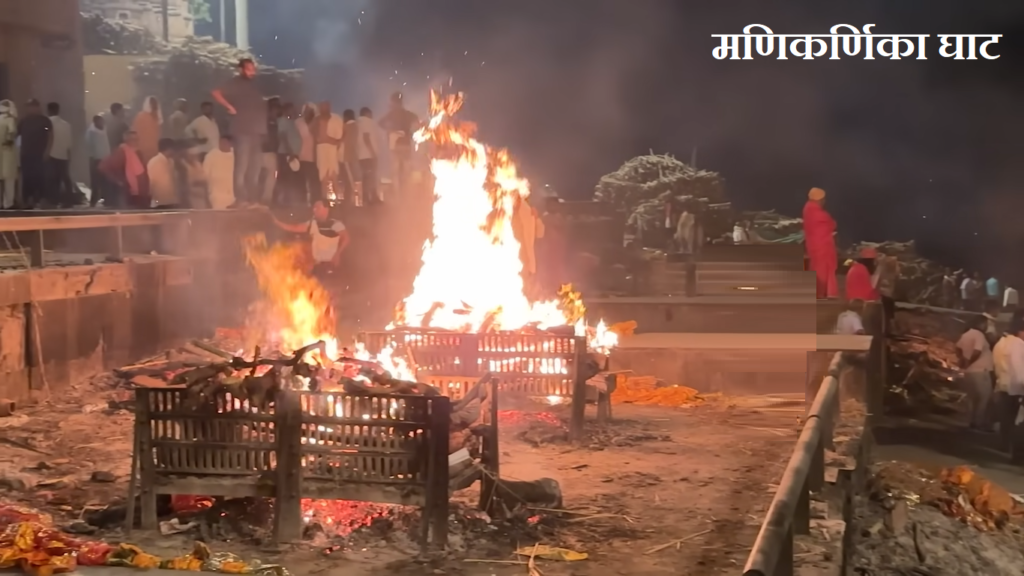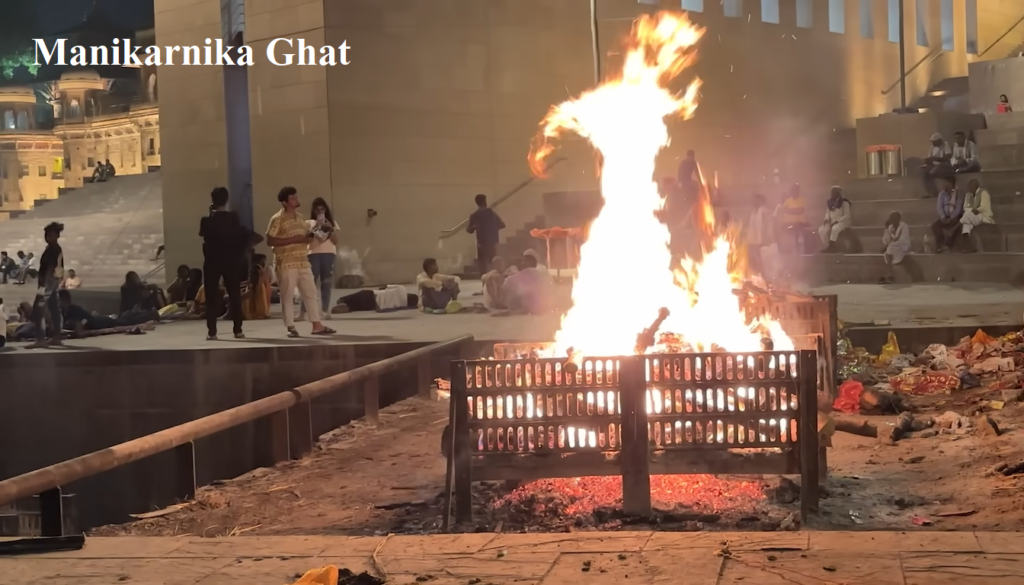Varanasi, located on the banks of the river Ganges in Uttar Pradesh, is one of the holiest cities in India and has been a spiritual center of Hindus for centuries. Varanasi is home to many centuries-old temples and shrines dedicated to various gods and goddesses. It is also a major center of learning and culture, and has produced some of India’s most renowned poets, philosophers, and musicians over the centuries. Varanasi is truly a unique tourist destination, offering something for everyone. Not only to live in Varanasi; people from different places come here to die. Yes, it is considered that dying in Varanasi will provide “Moksha”.
When talking about death in Varanasi, the famous ghat for cremation is Manikarnika Ghat. Manikarnika Ghat is one of the most sacred ghats of the legendary “Kashi Nagari”. It has been an important site for performing the Hindu rites of cremation and rituals of body disposal for centuries. Manikarnika Ghat is believed to be the place where human souls depart from this world to the next destination. If you are a travel enthusiast and Varanasi is in your bucket list, then you must visit the famous Manikarnika Ghat.
Glimpses of Varanasi along the Manikarnika Ghat

The Manikarnika Ghat is considered to be one of the most significant ghats in Varanasi. Even today, it is considered to be the holiest site for Hindus to perform the last rites of their dear ones. It is believed that performing the last rites at Manikarnika Ghat can provide the souls with Moksha, or liberation from the cycle of death and rebirth.
The Manikarnika Ghat is situated near the famous Kashi Vishwanath Temple, gets surrounded by the Dashashwamedh Ghat and the Scindia Ghat on both sides. In a Gupta monument from the 5th century, the Manikarnika Ghat is talked about. The stone stairs were built in 1303, and Bajirao Peshva helped rebuild them in 1730. Ahilyabai Holkar upgraded the entire ghat in 1791. At this ghat, there is also a holy pond called Cakra-Pushkarini Kund also known as the Manikarnika Kund. It is thought that Lord Vishnu dug this pond. History says that this kund was there before the Ganges started to flow.
At the moment, both pilgrims and people who want to be cremated come to this ghat in Kashi. This ghat is very important for religious and cultural events. When there is a Sun-lunar eclipse, Prabodhini and Nirjala Ekadashi, Makar Sankranti, Ganga Dussehra, Teej, Kajri, Chhath, or any other special occasion, it is especially important to take a bath here.
The Soulful Experiences of Manikarnika Ghat

Manikarnika Ghat is also known for its spiritual importance which draws numerous visitors from around the world all year long. It has become an unforgettable site to experience the great culture and tradition of Varanasi.
At the ghat, you will see, hear, and smell a lot of different things. On one spot, you might see a priest preaching to a large group of people, and on the other, you might see people taking part in funeral rites. As hundreds of bodies are thrown into the fire, the air is filled with smoke. This may tell people that death is inevitable and that everything in this world is temporary. It is also a reminder that we all have to face death when it comes, and that none of us can avoid it.
At night, there is less noise, people sit quietly around, and all you can hear is the sound of fire burning through bodies and a lot of wood. The fire itself looks beautiful at night because it gives off light in the dark. This is different from how it might look during the day.
Uncovering the Ancient History of Manikarnika Ghat
The Manikarnika Ghat, like all the other ghats in Varanasi, has an interesting mythological story that tells us how it got its name. When Mata Sati (Adi Shakti) gave up her life and set her body on fire because Raja Daksh, tried to humiliate Lord Shiva in a Yagya, Lord Shiva took her burned body to the Himalaya. When Vishnu saw Lord Shiva’s continuous agony, he sent the Divine chakra to cut the body into 51 parts, which subsequently dropped to Earth. These are known as “Ekannya Shaktipeeth”. Lord Shiva made Shakti Peeth in the place where Sati’s body fell. There are 51 Shakti Peeth that are connected to the 51 letters or akshar in the Sanskrit language. Mata Sati’s ear piece fell at Manikarnika Ghat. Manikarna in Sanskrit means Ear Rings. The Shakti of Manikarnika is called as Vishalakshi & Manikarni.
According to another legend, Vishnu spent a few thousand years of tapasya trying to persuade Shiva that he shouldn’t destroy the sacred city of Kashi along with the rest of the universe. Lord Shiva and Parvati went to Kashi before Vishnu did to help him get what he wanted. Vishnu dug a well (kund) on the Ganges bank for the couple to bathe in. Parvati was taking a bath when a jewel from one of his earrings fell into the kund. From this, the name Manikarnika comes. Another story about the ghat says that it was formed when Lord Shiva’s ear jewel fell to the ground while he was dancing angry dances.
Witnessing the Cycle of Life at Manikarnika Ghat
Manikarnika is one of Kashi’s five most important and oldest ghats. The ghat is also known as the Burning Ghat as hundreds of funeral pyres are lit all around the place every day. One can get a calm and divine experience by visiting this ghat and witnessing the soul-stirring rituals performed here.
It is one of the best places for a Hindu to be cremated. Bodies are brought to the ghat wrapped on a white colored cloth in a wooden stretcher that is moved by the doms. People from all walks of life come here to wait for the end of their lives. People celebrate death at the Manikarnika Ghat. Every hour of the day, sad chants are sung, and smoke fills the area day and night as dead bodies are burned to give them endless peace. Many people also call the ghat the “gateway to heaven.”
Every day, hundreds of people come to the ghat to perform the last rite and find peace for the dead. Those who get to see a death at Manikarnika Ghat will never forget it. It’s a heartbreaking sight that makes us feel a lot of sadness and loss. The body on fire is a sign of how people deal with death and a warning that life is short. Manikarnika Ghat is a unique site that transports us back to the ancient past. Almost certainly, a priest or, more likely, a guide will lead you to the top floor of a nearby building, where you can watch cremations.
The Rituals of the Spiritual Manikarnika Ghat
The usual ritual starts when the white cloth-wrapped dead body is brought in on a bamboo stretcher and the words “Ram naam satya hai” are chanted. On top of the ghat, there are huge piles of firewood. Each log is carefully weighed on huge scales to figure out how much the burning will cost. Every kind of wood has a different price, and sandalwood is the most expensive. Outcasts called “doms” take care of dead bodies and carry them on a bamboo bed wrapped in cloth through the streets near the holy Ganges. Before the body is burned, it is soaked in the Ganges. The body is washed in the Ganges and then burned on a pile of logs with clarified butter (ghee) and wood on top.
The elder son then lights the fire, with the help of the other mourners, keeps it going until the body is completely burned to ash. After that, the ashes are gathered and thrown into the Ganges. Together with the prayers and chants of the mourners, the intense heat and smoke from the fire make for a very special environment. When people are cremated, long bamboo sticks are used to break the heads of bodies that haven’t burned all the way down. This frees the soul from the body. In the end, about two hours later, the ashes of the bones would be gathered and thrown into the Ganges River. This meant that the souls had returned to their original state.
Seeing a body slowly being burned up by fire is both amazing and sad. It’s a warning of how fragile life is and how death is the end. It’s a lesson of how life and death go together. It is a powerful reminder to love and respect every moment of life and to never take it for granted.
Best Time to Visit
The best time to come if you want to see cremations is between 8 am and 8 pm. There is no fee to enter the ghat. It is strictly prohibited to take pictures as this may hurt the sentiments of the families. More than 300 bodies are burned at this ghat every day. So, it’s easy to catch a cremation ceremony at any time of the day. However, the sight is incredible at night.
How to Reach Manikarnika Ghat
Manikarnika Ghat is situated in Lahori Tola, Varanasi, Uttar Pradesh. It has good road connections to all the train stops, the airport, and the bus stop.
By Airways: The nearest airport in Varanasi is Lal Bahadur Shastri International Airport, Babatpur. It is about 25 km from the Manikarnika Ghat. From airport, one can take auto or book cab to reach the nearest stop.
By Roadways: You can take auto, taxis, or cabs from the bus stop or your location to Godoulia Chowk. You should walk towards Manikarnika Ghat from the Chowk. Manikarnika Ghat, on the other hand, can be reached by boat from either Dashashwamedh Ghat or Scindia Ghat.
By Railways: The nearest railway station to Manikarnika Ghat is Varanasi Junction. It is about 4.6 km. However, the ghat is located at the distance of only 5 km from the Banaras Railway Station. From either station, one can easily get road vehicle to reach Manikarnika ghat.
